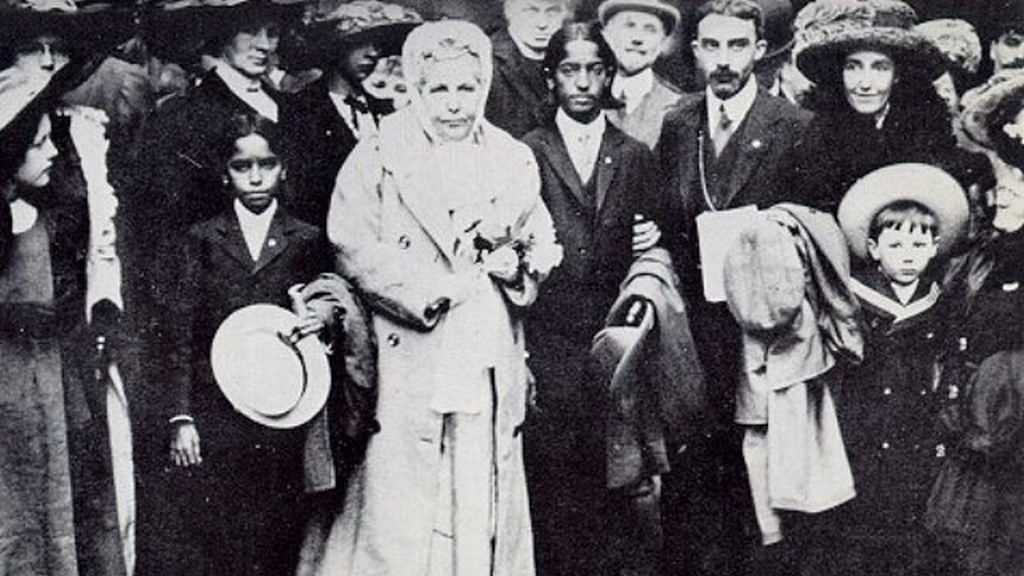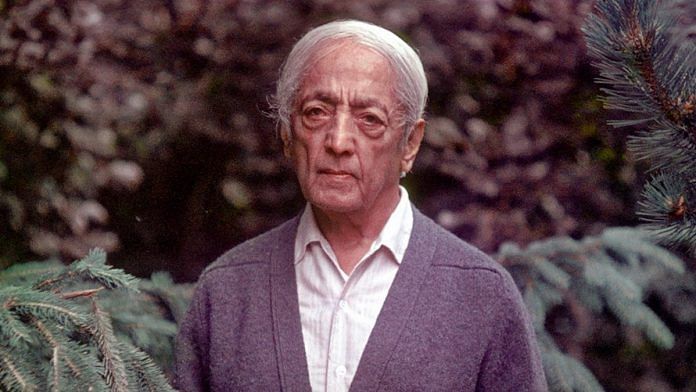New Delhi: Jiddu Krishnamurti’s core philosophy, which he stuck to until his last breath, was that “truth is a pathless land”. Yet, he was revered as a ‘world teacher’, guru, saint, and even messiah, despite his vehement disapproval of such titles. His books sold over three million copies and right until his death at the age of 91 on 17 February 1986, his lectures continued to draw thousands. For many, the quietly charismatic Krishnamurti was the very path itself.
In May 1985, Krishnamurti challenged an audience in Ojai, California, with a philosophical question and then asked them if they wanted an explanation from him. When they indicated they did, Krishnamurti joked, referring to himself in the third person: “You see, that’s what I’m objecting to… You are waiting for somebody to tell you. Therefore, he becomes the nasty guru and you become the follower.”
Born on 11 May 1895 to a humble Telugu-speaking family in the town of Madanapalle in Madras presidency, Krishnamurti was one of eleven siblings, with only six reaching adulthood. His mother, Sanjeevamma, died when he was about 10 and his father, Narayanaiah, was a clerk. By most accounts, the young Jiddu was a “frail and dreamy child” who did not show much academic promise. However, in 1909, he found himself thrust into the limelight as a would-be messiah shortly after his father joined a clerical position in the Theosophical Society, led by Annie Besant, in Adyar.
The April of that year brought about a great change in Krishnamurti’s life, when Charles Webster Leadbeater, a controversial figure of the Theosophical Society, spotted him at a beach. Leadbeater, who claimed to be a clairvoyant, was apparently struck by the child’s “radiant aura” and immediately proclaimed him as the next “world teacher”—a messianic figure in Theosophical beliefs. Thus started a long sojourn as a reluctant spiritual leader.
Also Read: Positive approach to life is destructive. There is no freedom at all: Jiddu Krishnamurti
‘World teacher’
From the moment he was discovered on the beach, Krishnamurti’s life became intertwined with the Theosophical Society, a movement that blended Western occultism with Buddhist and Hindu philosophy. Besant and Leadbeater reposed hopes in him of leading humanity into a new era of enlightenment and he was groomed to fulfill this grand destiny.
A new organisation, the Order of the Star in the East, was formed in 1911, with Krishnamurti at its centre as the “chosen vehicle of the World Teacher.” However, in 1929, he stunned the world by renouncing this role, dissolving the Order, and demanding that all its holdings be divested.

In a 1985 Los Angeles Times interview, Krishnamurti explained that the premise of his own godlike status felt “wrong” to him. Although his friends and “world leaders” advised him to maintain the Order of the Star as a platform, Krishnamurti concluded that it was all simply too “ugly”. Having broken free of the “cult”, he embarked on his solitary journey as a speaker and philosopher, dividing his time between India, the US, and Europe. But some things did not change. While constantly warning against the dangers of personality cults, religion, and dogma, he amassed an ever-growing flock of devotees.
“Krishna ji did not believe in the concept of master and disciples. He distanced himself from the Theosophical Society for the same reason. He did not like when people offered him garlands or worshiped him in any way,” said Vishwanath Alluri, secretary of the Krishnamurti Foundation India.
The teachings of Krishnamurti
When Krishnamurti addressed his audiences, he often began with a clear disclaimer: “I am not a philosopher.” He distinguished himself from traditional philosophers, noting that while they often relied on existing literature, he offered only his own point of view.
However, ‘philosopher’ is another label that Krishnamurti could not easily shed. His work contains numerous core principles that collectively form a philosophical framework centred around the fundamental principles of self-inquiry and self-awareness as the key to true understanding and freedom.
He emphasised the importance of observing one’s own mind without judgment, allowing for an unfiltered perception of reality. The mind, according to him, is conditioned by society, culture, and past experiences, clouding how we see the world.
Central to Krishnamurti’s philosophy was the notion of psychological revolution—a radical transformation of consciousness that transcends the ego’s limitations and the self-imposed barriers of the mind.
Another key theme is the concept of non-duality, the idea that there is no separation between the observer and the observed, the thinker and the thought. He argued that this dualistic thinking is the root cause of conflict and suffering in the world.
More concretely, Krishnamurti also argued that “organisations”, including nation-states and religions, were antithetical to peace and compassion. “Peace cannot possibly exist on this earth if there are nationalities,” he said. “And organisations cannot possibly bring about peace between man and man because he believes in something, he believes in certain ideologies, he believes in god and others don’t.”
Beyond his lectures and books, Krishnamurti, who considered education fundamental to personal development, established several schools under the Krishnamurti Foundation. It runs six schools in India, the best known being the Rishi Valley school in Andhra Pradesh near Madanapalle, Krishnamurti’s birthplace. These schools go beyond traditional subjects, enabling students to engage in activities like pottery and gardening.
“The Krishnamurti Foundation does not run traditional schools, we call them education centres,” said Alluri. “Each centre has three units—school, study centre, and a rural centre which is involved in outreach work in the rural neighbourhood in education, health, agriculture, and environment.”
Teachers and students in these schools share a friendly bond, Alluri added, unlike the traditional hierarchical relationship.
Also Read: Arya Samaj founder Dayanand Saraswati inspired Gandhi to Aurobindo, championed ‘Vedic truth’
Friends in high places, and a few critics
Krishnamurti’s rejection of messianic status attracted admiration from many, but others like Radha Rajagopal Sloss, author of Lives in the Shadow with J. Krishnamurti, argued that he didn’t fully relinquish his leadership role.
In her book, Sloss portrays Krishnamurti as detached from his followers, unlike a traditional teacher who takes responsibility for his actions. In an interview with Tricycle, she likened him to a “stock advisor” for his non-committal approach.
Sloss, who claims she has love letters to prove that her mother Rosalind had a 25-year-long affair with Krishnamurti, also characterises him as someone who lived a dual life, where his public teachings contrasted with his private actions. She further claims that the dissolution of the love affair led to legal battles between her family and the Krishnamurti Foundation. According to Sloss, her father, Rajagopal, also part of the Foundation, was removed from the inner circle responsible for publishing Krishnamurti’s work.
However, criticisms barely dented the philosopher’s reputation. Throughout his life, Krishnamurti attracted numerous celebrities and political leaders, who sought his advice. One of them, famously, was Indira Gandhi, who reportedly met him at a dinner party in the 1950s, starting a friendship that endured through the decades. According to Pupul Jayakar’s biography of Krishnamurti, Indira Gandhi decided to call for elections during Emergency after consulting Krishnamurti despite her son Sanjay’s advice to postpone them for years.
Messiah or not, teacher or not, Krishnamurti left a lasting legacy, with his ideas resonating in the discourses of several other spiritual leaders, including Osho and Sadhguru. His last public talk in Chennai, just weeks before his death from pancreatic cancer, captured his essence: probing the origins of life without offering simplistic answers. “This is the last talk,” he said in conclusion. “Do you want to sit together quietly for a while? All right sirs, sit quietly for a while.”
(Edited by Asavari Singh)



